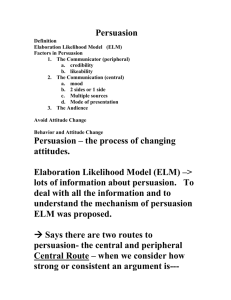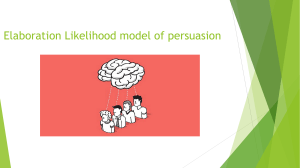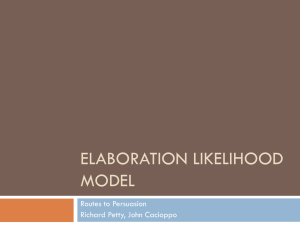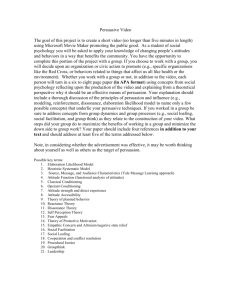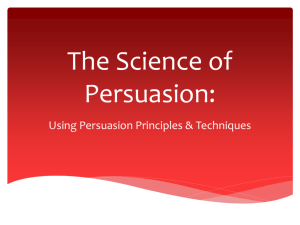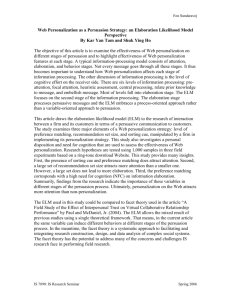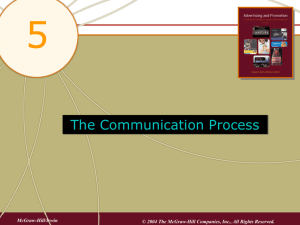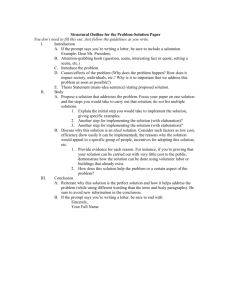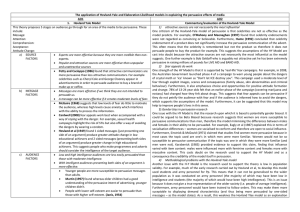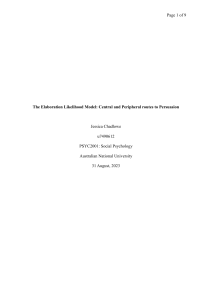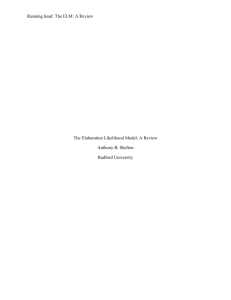Elaboration Likelihood Model: Persuasion in Health Communication
advertisement
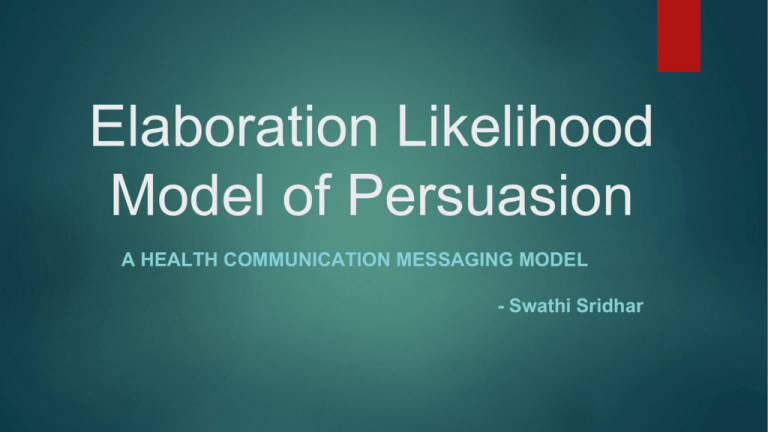
Elaboration Likelihood Model of Persuasion A HEALTH COMMUNICATION MESSAGING MODEL - Swathi Sridhar Outline: • • • • • Health communication through persuasion Elaboration Likelihood Model (ELM) Key Features of ELM model Example for each routes of information processing Two video activity Health Communication: ● Short powerful message → Efficient format ● Messaging characteristics ○ Message characteristics ○ Source Characteristics ○ Target characteristics ● Goal of health communication → Proximal mediators “Attitude”. Health Communication: Elaboration Likelihood Model (ELM) : “Attitudes can be formed or changed based on the amount and nature of thinking and if we could change a specific attitude towards a behavior, then we could change the behavior ” What is ELM? ● Attempt to change attitude → Elaboration = Thinking process → likeliness to persuasion → behavior change. ● Use- Tailoring health communication (message) History: • Dr. Richard E Petty and Dr. John T Cacioppo (1986, 1996) • Social psychology theory – persuasive messaging • Most influential of information change dual process models Central Tenets of ELM • Degree of elaboration is determined by a) motivation b) ability to think • Information process = continuum of elaboration (low end - high end) with 2 routes of processing a) Peripheral route b) Central route • Depending on where people fall on the continuum (i.e the degree of elaboration), variables influence differently. • Degree of elaboration in persuasion determines the attitude consequence. How we process information? - Two routes to persuasion Peripheral cues Intellectually engaging CENTRAL ROUTE PROCESSING (Cognitive) PERIPHERAL ROUTE PROCESSING (Associative) Central Route Example Target- mot. & ability Message *Statistics *Perceived threat *Quality of argument Source *CDC High involvement messaging Careful scrutiny of information Enduring Attitude formation Behavioral Intention PERIPHERAL ROUTE EXAMPLE Peripheral cues: mood (Target) Surface factors: simple (Message) Source: CDC, web MD (Source) Expedited Judgment formation Behavioral intention – Temporary THE THEORY OF TRIADIC INFLUENCE Levels of Causation Ultimate Causes Intrapersonal Stream Biological/Nature BIOLOGY/ PERSONALITY 1 Social/ Personal Nexus Dista lInfluences Expectancies & Evaluations 2 Sense of Self/Control Self Determination Proxima lPredictors Decision s 8 Skills: Social+General 14 SOCIAL SITUATION 4 Interpersonal Bonding Others’ Beh & Atts 9 10 Motivation to Comply Perceived Norms 15 SELF-EFFICACY BEHAVIORAL CONTROL Cultural/Attitudinal Stream Nurture/Cultural 3 Social Competence 7 13 Affect and Cognition s Social/Normative Stream CULTURAL ENVIRONMENT 5 Interactions w/ Social Instit’s 12 Values/ Evaluations 16 20 Information/ Opportunities 11 Knowledge/ Expectancies 17 21 DECISIONS/INTENTION S 22 Trial Behavior EXPERIENCES: Expectancies -- Social Reinforcements -- Psychological/Physiological Experiences 23 18 ATTITUDES TOWARD THE BEHAVIOR SOCIAL NORMATIVE BELIEFS 19 6 Video Activity: 1. https://www.youtube.com/watch?v=Aq9mkRr_E7c 2. https://www.youtube.com/watch?v=GSZyZMOzRs0 1. What route of persuasion attempt is used in these Videos? 2. Identify: • Message characteristics • Target characteristics • Source characteristics • Audience factors • Processing approach • Persuasion outcome • How likely are you to perform the behavior based on the commercial?
